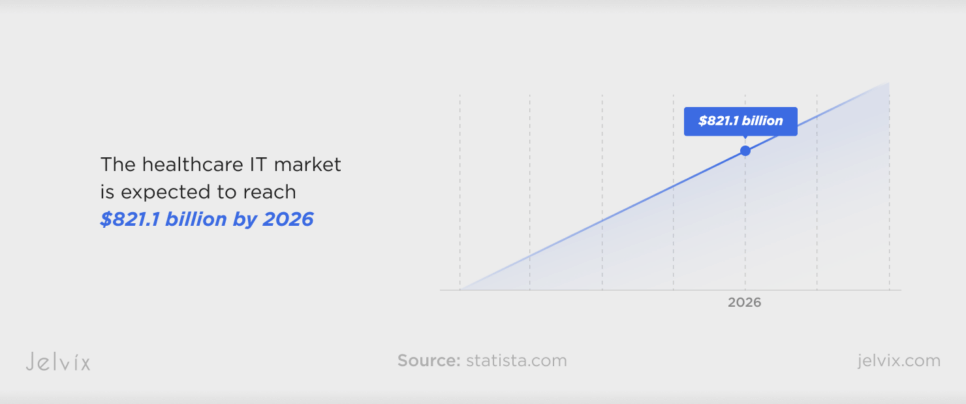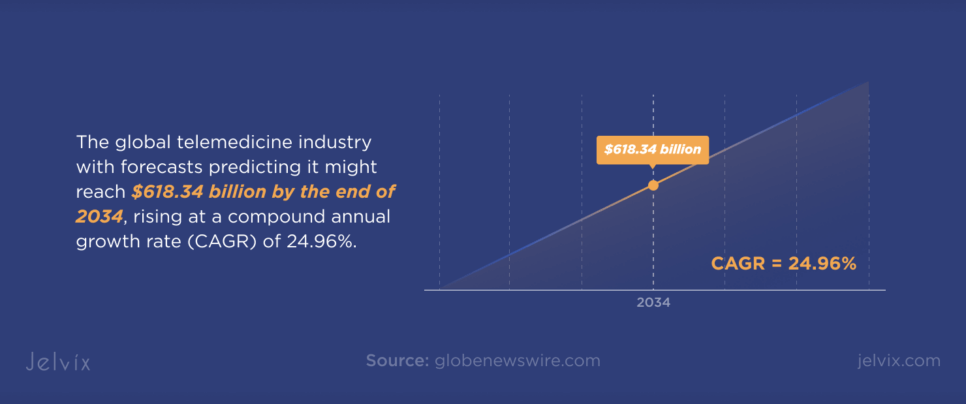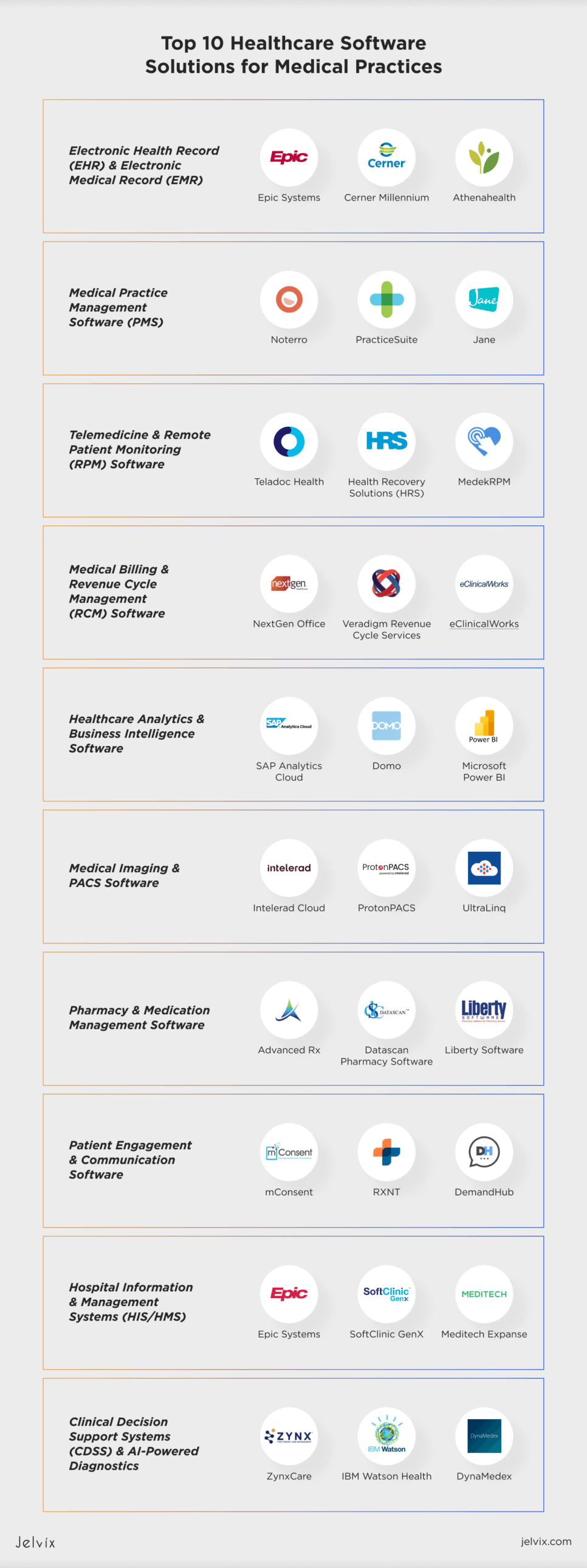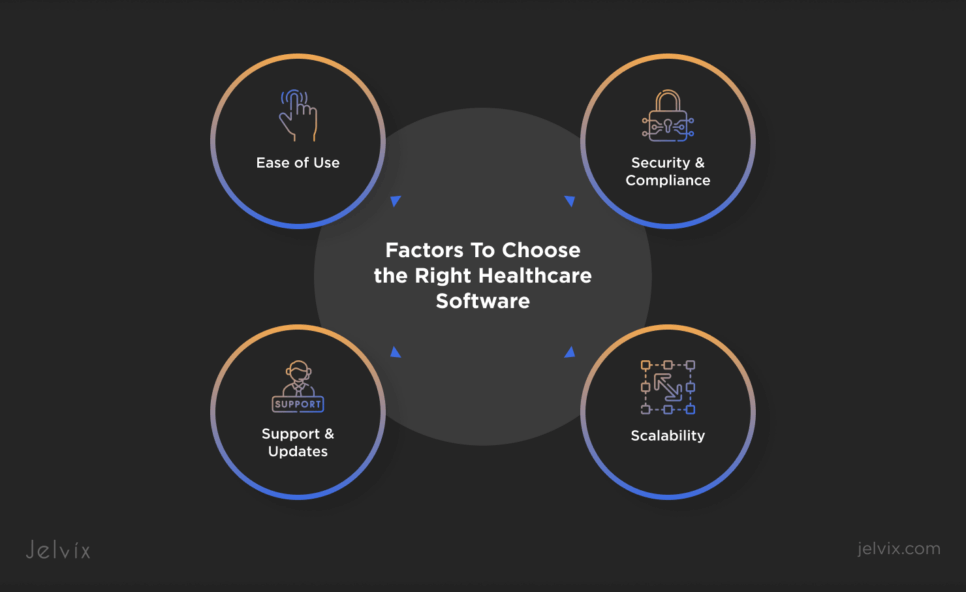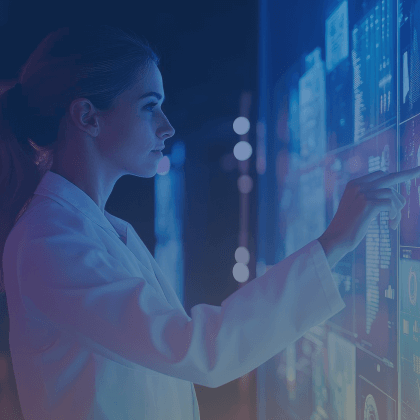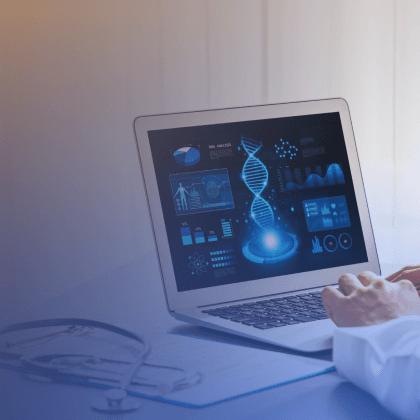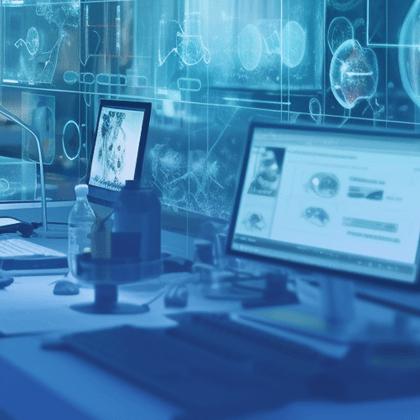The healthcare sector has progressed much beyond paper documentation. Today, healthcare software solutions enable clinics and hospitals to improve patient care, accelerate operations, and reduce errors. The software handles everything from patient records to scheduling, invoicing, and even remote doctor visits.
While certain apps examine patient data to forecast health concerns, others focus on medical imaging, guiding doctors in reading X-rays and MRIs. Basically, digital solutions help doctors and nurses spend more time with patients and maintain medical facilities running smoothly.
With telehealth usage is expanding at a 24% rate, the healthcare IT market is expected to reach $821.1 billion by 2026. 95% of hospitals use electronic health records, and AI-powered analytics guide doctors in predicting and avoiding medical issues.
Software solutions will continue to transform the future as demand for faster, more connected healthcare rises and medical treatment becomes safer, smarter, and more efficient. And we are riding the wave of innovations. So, let’s see what the market offers as IT solutions for healthcare, their benefits, and future trends.
Key Trends in Healthcare Software
The healthcare software is changing quickly. Numerous important factors help to define its direction. The emergence of AI and machine learning (ML) marks one of the important changes. Aiming to lighten the burden on healthcare staff, hospitals are using AI to help with tasks, including medical documentation.
India’s Apollo Hospitals, for example, have made investments in AI systems to automate repetitive chores, freeing two to three hours daily for doctors and nurses. However, it’s crucial to remember that while AI offers many benefits, studies have shown that some AI systems may miss severe health issues, stressing the need for careful installation and constant review.
Another key trend is the rise of telemedicine and remote patient monitoring. The global telemedicine industry has undergone substantial growth, with forecasts predicting it might reach $618.34 billion by the end of 2034, rising at a compound annual growth rate (CAGR) of 24.96%. This spike is linked to the widespread recognition of telemedicine as a viable alternative to traditional healthcare delivery.
Data security and compliance challenges are also at the top of healthcare conversations. Given hospitals incorporate ever more advanced software solutions, patient data protection becomes absolutely vital. Including AI and ML in healthcare systems depends on robust data security measures to protect patient information and maintain regulatory compliance.
Furthermore, changing hospital utilization of medical software is the drive toward interoperability and cloud-based solutions. Simple data exchange among healthcare professionals, made possible by cloud-based technology, improves patient care coordination. However, this change also brings difficulties with data security and regulatory compliance, which emphasizes the need for strong protections.
Top 10 Healthcare Software Solutions for Medical Practices
Electronic Health Record (EHR) & Electronic Medical Record (EMR)
If such challenges as long wait times, lost paperwork, and scattered patient records sound familiar, Electronic Health Record (EHR) and Electronic Medical Record (EMR) software can help. Though frequently used interchangeably, they have different applications. EMRs are digital versions of paper charts used within a single practice, tracking medical history, diagnoses, and treatment plans.
Conversely, EHRs span more ground. They guarantee coordinated treatment wherever a patient visits by allowing smooth sharing of patient data among several physicians, hospitals, and even states. Both types of software improve efficiency, reduce errors, and help healthcare professionals spend more time with patients instead of paperwork.
A second focus is security; built-in HIPAA-compliant protections guarantee that patient data stays safe. Above all, these systems are made for simplicity of use. Their clear dashboards and mobile access let doctors and nurses access vital data anywhere.
Choosing the right platform depends on your clinic’s needs. The most trusted and favorable are:
- Epic Systems: Well-known for its extensive capabilities and flexibility, Epic dominates big hospital systems and healthcare networks. Its strong reporting features enable evidence-based decision-making.
- Cerner Millennium: Hospitals and healthcare networks embrace Cerner, a cloud-based platform, with real-time data access and speech recognition for its adaptability and sophisticated capabilities.
- Athenahealth: Starting at $140 per provider monthly, Athenahealth serves small to medium practices and is well-known for revenue cycle management and AI-driven analytics.
Medical Practice Management Software (PMS)
Maintaining a medical practice calls for arranging visits, processing insurance claims, keeping records, and ensuring adherence to constantly changing rules and regulations. By automating these typical tasks, decreasing mistakes, and increasing general efficiency, Medical Practice Management Software (PMS) releases the weight of your staff.
A well-integrated PMS can transform daily operations with:
- Smarter Scheduling & Patient Flow: Advanced scheduling solutions stop double booking, provide automated reminders to minimize no-shows, and allow online booking for maximum patient convenience.
- Seamless Billing & Insurance Processing: PMS reduces denials and accelerates reimbursements by automating claim filings, real-time insurance eligibility verification, and missing information flagging before claims are issued.
- Centralized Patient Records & Documentation: PMS compiles patient records, notes, and medical histories onto a single, readily available dashboard. Doctors, nurses, and administrative staff members, with the knowledge they need at their fingertips, make faster and more informed decisions.
- Regulatory Compliance & Data Security: Compliance with HIPAA, GDPR, and other healthcare laws is included in many PMS systems under regulatory compliance and data security. Automated audit trails, safe cloud storage, and role-based access control help to guard private patient information and make sure clinics satisfy legal criteria.
When considering PMS, here are some top vendors to explore:
- Noterro: Noterro provides customizing scheduling, client management, billing, and marketing solutions for massage therapists and bodywork practitioners.
- Jane: A cloud-based solution for healthcare and wellness professionals, Jane provides online booking, charting, and billing features.
- PracticeSuite: A comprehensive platform offering scheduling, billing, and revenue management in a cloud-based environment.
Telemedicine & Remote Patient Monitoring (RPM) Software
Driven by a need for easily available and effective healthcare, telemedicine has become rather popular. The global telemedicine market was valued at $87.41 billion in 2022 and is expected to reach $286.22 billion by 2030. Technological developments, the growing demand for remote treatment, and the increasing frequency of chronic diseases all help drive this expansion.
The remote patient monitoring market is also rapidly expanding, reflecting a compound annual growth rate of 26.7%. Income is predicted to reach $175 billion by 2027. Virtual healthcare solutions provide patients with convenience and continuous monitoring while minimizing the load on healthcare institutions, pointing to a major change in them.
And some vendors are ahead of this change:
- Teladoc Health: One of the biggest names in telemedicine, Teladoc Health makes it easy for doctors and patients to connect through virtual visits. Their software also enables clinicians to monitor patients with long-term health issues without in-person visits using smart health gadgets.
- Health Recovery Solutions (HRS): By helping clinics and hospitals monitor patients remotely, HRS streamlines treatment and minimizes pointless hospital visits. Their software gathers real-time health information, notifies doctors when something seems unusual, and sends patients reminders. This reduces medical expenses and keeps patients healthier.
- MedekRPM: MedekRPM allows patients to monitor their health at home and updates doctors. The platform confirms patients follow their treatments and promotes simple communication, enabling doctors to manage continuous illnesses like diabetes or heart disease.
Medical Billing & Revenue Cycle Management (RCM) Software
Managing the financial aspect of a medical practice is no little task. From filing insurance claims to monitoring payments and cutting billing mistakes, every stage of the revenue cycle influences cash flow. By automating these tasks, Medical Billing and Revenue Cycle Management (RCM) software guarantees providers receive payment sooner and with fewer errors. This results from:
- Automated Claims Processing: RCM software extracts data directly from electronic health records (EHRs), minimizing human mistakes that cause claim denials. Several systems also employ AI-powered scrubbing tools to find missing details before submission.
- Faster Collection of Payments: Patients get bills by email or SMS and can pay online instead of via slow paper-based methods since built-in electronic invoicing and payment processing lets them do so. Many RCM healthcare applications link with insurance verification systems to confirm patient coverage before the treatment, guiding physicians on how much to bill insurance versus the patient.
- Improved Cash Flow & Financial Insights: Many RCM systems provide real-time financial analytics, tracking income patterns, outstanding claims, and patient balances. Thus, healthcare managers can recognize financial challenges early on and act quickly rather than waiting until the end of the month.
Depending on the size and features available, there are 5 top players in the billing sector:
- Veradigm Revenue Cycle Services: This platform focuses on approving insurance claims. It verifies reports twice before submission, reducing mistakes that cause denials.
- NextGen Office: Perfect for small and mid-sized businesses, NextGen streamlines medical billing with built-in templates designed for various fields. It also provides reminders for patient payments, facilitating the collection of outstanding amounts without additional manual work.
- eClinicalWorks: Known for its financial forecasts backed by AI, this system enables clinics to monitor cash flow and identify early financial problems. It also connects with EHRs, permitting direct patient medical chart billing.
- athenaIDX: For big healthcare companies, athenaIDX links several hospital systems and insurance companies. It specializes in managing difficult billing situations, such as multiple insurance coverages for one patient, ensuring no payments go unnoticed.
- AllegianceMD: Unlike other RCM software, AllegianceMD is fully cloud-based. So, staff can access billing and financial reports from anywhere. It’s a great fit for clinics with multiple locations or those transitioning to remote administrative work.
Healthcare Analytics & Business Intelligence Software
Modern Healthcare Analytics & Business Intelligence (BI) software gathers and examines data from many sources. These solutions increase providers’ efficiency and help to improve healthcare services by transforming unprocessed data into useful knowledge.
Predictive analytics lets hospitals and doctors foresee health hazards. ML systems can identify early warning signals of diseases such as sepsis or heart failure by examining patient histories, test findings, and even genetic data. Concurrently, operational and financial efficiency technologies enable clinics to monitor income patterns, identify billing mistakes, and expedite insurance claim approvals.
Beyond only improving finances, these types of medical software enable hospitals to manage resources in real time. Tracking bed occupancy rates, ICU capacity, and medical supply levels, cloud-based systems modify patient flow to reduce crowding.
AI-driven image analysis is also transforming diagnoses. Powerful deep learning models in BI tools may find abnormalities in X-rays and MRIs with up to 90% accuracy, enhancing early disease identification. Finally, Natural Language Processing (NLP) is used by compliance and fraud detection systems to search billing records and doctor’s notes for inconsistencies.
Features like this make Healthcare Analytics & BI programs increasingly important in modern medicine. And these rank first on the medical software list:
- SAP Analytics Cloud: A cloud-native BI tool combining financial reports, patient information, and EHR data into a single dashboard. It supports machine learning-powered forecasting and real-time data streaming, helping hospitals to make informed decisions.
- Microsoft Power BI: Power BI offers interactive visuals and automatic report generation for tracking patient demographics, readmission risks, and financial KPIs. It is well-known for its seamless integration with Azure and SQL databases and advanced queries, supported by DAX (Data Analysis Expressions).
- Domo: A mobile-first BI tool meant to let healthcare managers explore self-service data. It guarantees perfect data interoperability between hospital systems, insurance companies, and government health organizations by integrating with HL7 and FHIR (Fast Healthcare Interoperability Resources).
Medical Imaging & PACS Software
Manual image interpretation is the foundation of traditional radiography, which can be labor-intensive and prone to human mistakes. But AI-powered imaging tools examine thousands of scans in seconds, identifying minute patterns missed by even experienced radiologists.
By histopathological image analysis, an AI model known as ECgMPL, for instance, has attained a 99.26% accuracy rate in identifying endometrial cancer—a notable increase over previous automated approaches with an accuracy range of 78.91% to 80.93%. This model uses deep learning algorithms to analyze tissue samples at a cellular level, spotting cancerous cells depending on distinct structural characteristics typically too faint for the human eye to discern.
Likewise, AI-based technologies are improving lung nodule and breast cancer diagnosis, surpassing 90% in accuracy. These systems are based on convolutional neural networks (CNNs), a kind of AI model trained on an enormous collection of medical images. CNNs can indicate possible anomalies, assign risk levels, and even provide radiologists with next actions by identifying trends in thousands of already diagnosed patients.
AI addresses workflow automation in addition to disease identification. Certain AI-enhanced PACS (Picture Archiving and Communication Systems) systems automatically filter and prioritize urgent situations, guaranteeing that important scans—such as possible strokes or tumors—are seen first.
Several PACS software providers offer reliable tools to help doctors and hospitals store, manage, and share medical images more easily:
- Intelerad Cloud: A web-based system that lets healthcare providers store and access medical scans securely from anywhere.
- ProtonPACS: A flexible system designed for both small clinics and large hospitals. It can handle different amounts of image data, making it a good fit for growing medical practices.
- UltraLinq: A cloud-based tool that makes sharing and organizing medical images simple. It helps doctors work together more easily by giving them quick access to scans, no matter where they are.
Although AI-powered medical imaging tools have shown amazing accuracy in identifying diseases, it’s crucial to keep in mind that AI is only a tool—not a substitute for human knowledge. These algorithms help clinicians make wise decisions by rapidly processing enormous volumes of data and pointing out possible problems. They are not perfect, though; misinterpretation still occurs—especially in complicated or uncommon circumstances.
Radiologists and other medical experts still have the last say. AI may suggest outcomes; nevertheless, given patient history, symptoms, and clinical setting, a trained expert must analyze and validate findings. AI cannot quite duplicate the human brain’s capacity for reason, pattern analysis, and critical thinking.
Pharmacy & Medication Management Software
E-prescribing allows doctors to send prescriptions directly to pharmacies using a secure digital system, replacing handwritten notes. This helps minimize errors brought on by lost paper prescriptions or poor handwriting. Changing to digital prescriptions has been shown in a study published in BMJ Quality & Safety to reduce drug mistakes and increase patient safety. By seeing possible problems like harmful drug combinations before the prescription is filled, e-prescribing has also helped hospitals decrease adverse drug responses.
Real-time drug interaction checks are another crucial tool included in medication management systems, as highlighted in research published in The Pharmaceutical Journal. These algorithms notify pharmacists and doctors automatically should a prescription medication cause issues when taken with another drug a patient is on. This additional degree of protection guarantees the best therapy possible and helps to avoid negative side effects.
Several pharmacy and medication management software solutions have emerged to enhance e-prescribing and medication safety:
- Advanced Rx: This system provides point-of-sale integration, e-prescription writing, and medication therapy management. Strong reporting capabilities and an intuitive interface help pharmacies maintain compliance and enhance patient care.
- Datascan Pharmacy Software: Made for independent pharmacies, Datascan offers inventory control and prescription processing solutions. Its real-time data analytics and adjustable dashboard support effective pharmaceutical operations.
- Liberty Software: Liberty provides e-prescription, medication synchronizing, and adherence monitoring among pharmacy management tools.
Patient Engagement & Communication Software
Effective healthcare results from doctors and patients communicating clearly and simply. For scheduling, reminders, follow-up, and medical updates, 80% of patients choose digital communication, including emails, SMS, video calls, and patient portals. Many people feel that mobile technology speeds up, simplifies, manages, and reduces the burden of their healthcare experience.
The following healthcare communication software makes people more satisfied with hospitals’ services:
- mConsent: A simple tool that lets patients schedule appointments online and sends automated reminders.
- DemandHub: Designed for small clinics, it improves patient communication, boosts online reviews, manages feedback, and strengthens customer engagement.
- RXNT: A complete system that offers scheduling, billing, patient messaging, and medical record management.
- PrognoCIS: Combines EHR, telemedicine, automated reminders, and patient engagement tools, ensuring doctors can track patient history and offer virtual visits with ease.
- athenaOne: A fully integrated platform that handles medical records, billing, patient messaging, prescription tracking, and care coordination.
Hospital Information & Management Systems (HIS/HMS)
Hospital information systems (HIS) are digital systems designed to help hospitals manage patient data, staff schedules, billing, and other administrative chores. For example, the Royal Hobart Hospital in Tasmania replaced paper charts with a digital system called the Patient Alerts Management Solution (PAMS). This adjustment resulted in a notable rise in weekly documented patient alerts, enhancing patient safety and saving staff time on documentation.
Here are some leading Hospital Information System providers:
- Epic Systems: Yes, we mentioned them at the beginning. Holding nearly 38% of the U.S. market share, Epic is known for its comprehensive and scalable solutions.
- SoftClinic GenX: Used in over 25 countries by over 20,000 physicians, SoftClinic GenX offers a wide range of modules covering laboratory, pharmacy, outpatient, inpatient, and financial accounting.
- Meditech Expanse: A comprehensive HIS that includes modules for admissions, emergency department management, bed management, laboratory information systems, and pharmacy services.
Clinical Decision Support Systems (CDSS) & AI-Powered Diagnostics
By examining vast volumes of organized and unstructured medical data from many sources—including EHRs, medical imaging, laboratory testing, wearable health devices, and clinical studies—AI-powered Clinical Decision Support Systems (CDSS) work. These technologies help medical personnel make more accurate and fast judgments thanks to machine learning (ML), natural language processing (NLP), and deep learning algorithms in pattern recognition and outcome prediction.
Deep neural networks (DNNs), which learn from thousands—or perhaps millions—of historical cases, are one of the main AI methods applied in diagnostic CDSS. As a result, we have:
- Image Recognition & Disease Detection: AI-driven models, such as convolutional neural networks (CNNs), scan and analyze X-rays, MRIs, and CT scans pixel by pixel to detect anomalies like tumors or fractures.
- Predictive Analysis for Patient Risk Assessment: Gradient-boosted decision trees and AI-based recurrent neural networks (RNNs) examine patient records, lab findings, and genetic data to forecast illness progression in predictive analysis for patient risk assessment. AI models taught on electrocardiogram (ECG) data, for instance, can identify abnormal heart rhythms suggestive of early-stage cardiac disease.
- Natural Language Processing (NLP) for Clinical Insights: AI-powered CDSS systems scan clinical notes, research papers, and case studies to provide evidence-based recommendations in real time.
- Automated Alerts & Workflow Optimization: AI-based CDSS technologies cross-reference patient prescriptions with medical history to instantly identify drug combinations, dosing mistakes, or possible allergic responses.
Several Clinical Decision Support Systems (CDSS) integrate AI to enhance patient care:
- IBM Watson Health: Interprets unstructured data from several sources using Natural Language Processing (NLP), offering evidence-based therapy recommendations. It is available on several devices and fits very well with existing hospital systems.
- ZynxCare: Offers evidence-based clinical decision support solutions that help healthcare organizations standardize, analyze, and improve patient care.
- DynaMedex: Combines clinical expertise with extensive, curated disease content, offering AI search capabilities to provide users with evidence-based insights.
These more than 5 different types of software used in the healthcare industry—from EHR to AI-powered diagnostics—play a crucial role in modernizing practices. And it’s just the tip of the iceberg. Therefore, the question remains: which medical computer software suits your case?
How To Choose the Right Healthcare Software
Choosing the best healthcare software depends on your practice’s size, needs, and goals. To make the best pick, always think about the following factors:
- Ease of Use: The software should be simple to use so staff can learn it quickly. It must work smoothly with already existing systems;
- Security & Compliance: The platform should meet HIPAA, GDPR, or other legal requirements to protect patient data;
- Scalability: It should be flexible enough to grow with your practice.
- Support & Updates: Reliable customer support and regular updates ensure the software stays efficient and secure.
Above, we discussed what types of healthcare software are on the market, and most of them include ready-made systems. These are excellent, but sometimes some tailoring is needed.
Enterprise Software vs. Custom Development
Designed for hospitals, clinics, and medical groups, healthcare enterprise software provides ready-made solutions. These systems are quick to use since they offer pre-built capabilities like patient scheduling, invoicing, and reporting. Their continuous support and security updates guarantee adherence to healthcare regulations as well. They might, however, include pointless tools or a lack of customizing choices, which would force some companies to modify their processes to fit the software instead of the other way around.
Conversely, custom healthcare software is designed specifically for a medical practice or hospital. This allows it to be precisely matched to particular requirements by including just the required features. Customized solutions guarantee a perfect fit with current systems and provide more freedom. To develop, though, they demand more time and money and call for constant upkeep and qualified developers. Custom software offers a perfect fit, but for smaller businesses needing a quick fix, it might not always be the best option.
The Smart Way to Choose – Download Your Guide to Selecting the Right Healthcare Tech Partner!

Benefits of Custom Healthcare Software Solutions
We’ve already covered the main benefits of custom healthcare software, including tailored functionality, better system integration, enhanced security, scalability, and cost savings over time. Here’s a quick recap:
- Tailored Functionality: Custom software is designed to meet specific needs;
- Better System Integration: It connects seamlessly with existing platforms;
- Enhanced Security & Compliance: Custom solutions allow healthcare organizations to implement stronger data protection and ensure compliance with HIPAA, GDPR, and other regulations;
- Scalability: As a hospital or clinic grows, custom software can adapt and expand without requiring major changes;
- Cost Savings over Time: While initial development may require investment, custom software eliminates expensive licensing fees and reduces inefficiencies, leading to long-term savings.
These statements can be backed up by the following case studies:
- Cambridge University Hospitals & Epic Systems: The hospital transitioned from paper to digital records using a custom Epic Systems EHR, integrating over 2.1 million records and improving real-time data access for better decision-making.
- Jelvix Electronic Health Record System: Jelvix created a customized EHR system specifically for a healthcare provider. The solution ensured flawless integration with the current hospital infrastructure, leading to improved patient data management, automated processes, and enhanced accessibility.
Discover how we developed a personalized EHR system that optimized the clinic’s workflow while ensuring maximum privacy and security.
These case studies demonstrate how specifically tailored healthcare software may solve challenging issues, increase efficiency, and improve patient care in ways not possible with off-the-shelf solutions.
Future of Healthcare Software Solutions
As we have seen, systems driven by AI enable clinicians to forecast illness risks, make quicker, more accurate decisions, and even automate hospital processes. Blockchain technology and cloud computing will, however, mark the next significant change. More hospitals and clinics are migrating their systems to the cloud to safely access and store patient data anywhere.
Instantaneous medical record sharing made possible by cloud-based healthcare systems improves specialist collaboration and helps reduce treatment delays. Since hospitals no longer require pricey on-site servers to handle medical data, they additionally cut IT expenses. However, security remains a top concern, as healthcare data is a prime target for cyberattacks, making encryption and regulatory compliance essential.
Blockchain technology is then filling in here. By creating a tamper-proof record of patient data, blockchain ensures that medical records are accurate, secure, and only accessible to authorized individuals. It can also trace drug supply chains, eliminate billing fraud, and enhance patient consent management. Blockchain-based EHRs are now under test at some institutions, demonstrating that this technology is not only a buzzword but also a game-changer for transparency and healthcare security.
Healthcare software is headed toward a future faster, safer, and more efficient for everyone as AI makes diagnostics smarter, cloud platforms improve access to care, and blockchain protects patient data.
Conclusion
Healthcare technology is only becoming more important and changing how medical practitioners, clinics, and hospitals run. From cloud-based patient records and blockchain security to AI-driven diagnostics, software is now central in modern medicine rather than only a supporting tool. These innovations make quality healthcare accessible to everyone. As technology continues to evolve, the healthcare industry must adapt.
At Jelvix, we think that the power of human experience cannot be replaced, yet the correct tools can enhance it. Whether it’s creating safe health data systems, implementing AI-driven decision-making tools, or including predictive analytics into medical processes, we help healthcare professionals unleash their full potential. Let’s build the future of healthcare together! Reach out to the Jelvix team today.
FAQ
What are the key benefits of healthcare software?
Through AI and analytics, healthcare software guarantees compliance with industry regulations, automates administrative processes, increases efficiency, improves patient care, and allows better data management.
What are the biggest challenges in implementing healthcare software?
High implementation costs, data security risks, system interoperability problems, staff training needs, and regulatory compliance define the major challenges of healthcare software implementation.
What industries benefit the most from healthcare software?
Healthcare software benefits industries, including hospitals, clinics, telemedicine providers, pharmaceutical businesses, medical research institutes, and insurance companies.
How does healthcare software ensure data security?
To protect sensitive patient information from breaches and cyber threats, healthcare software employs encryption, multi-factor authentication, access control, HIPAA, GDPR, and other law compliance methods.
How is blockchain transforming healthcare software?
Blockchain guarantees transparent and tamper-proof medical records, strengthens interoperability, and accelerates processes like patient identity verification and safe data sharing, improving data security.
Need high-quality professionals?
Boost your business capacity with the dedicated development team.


